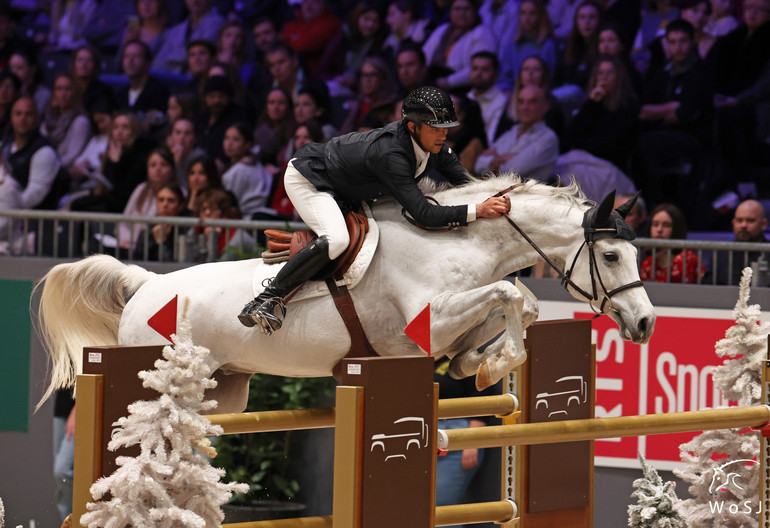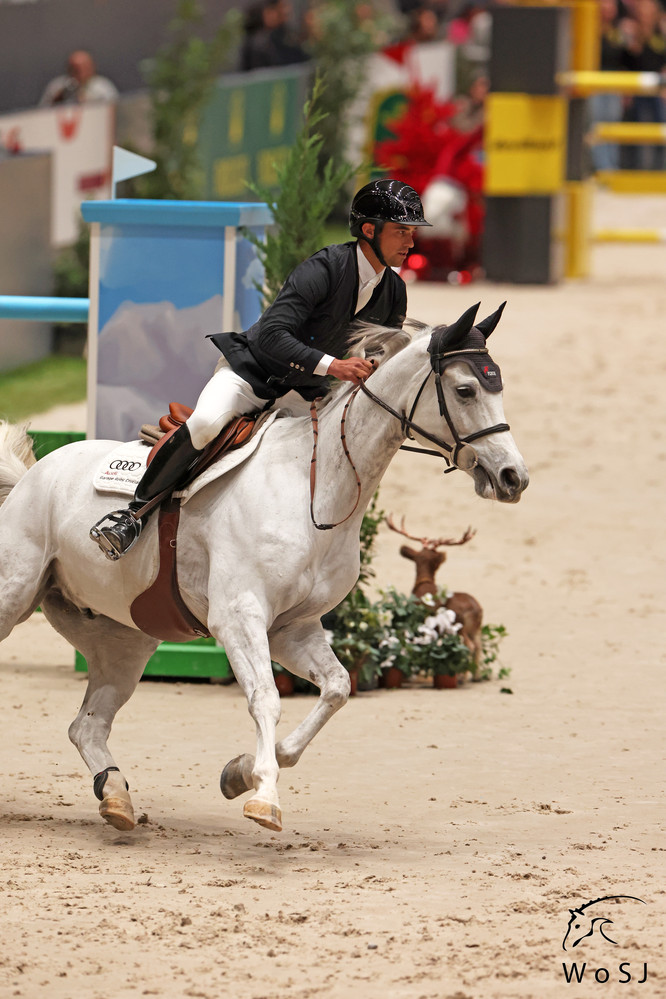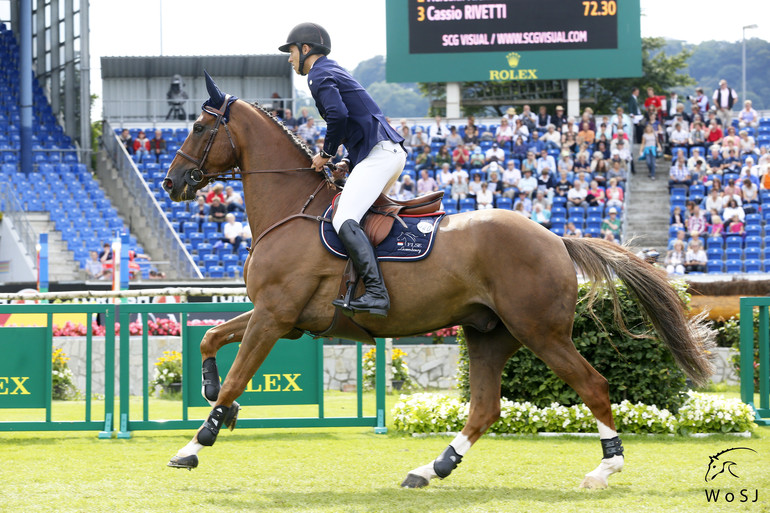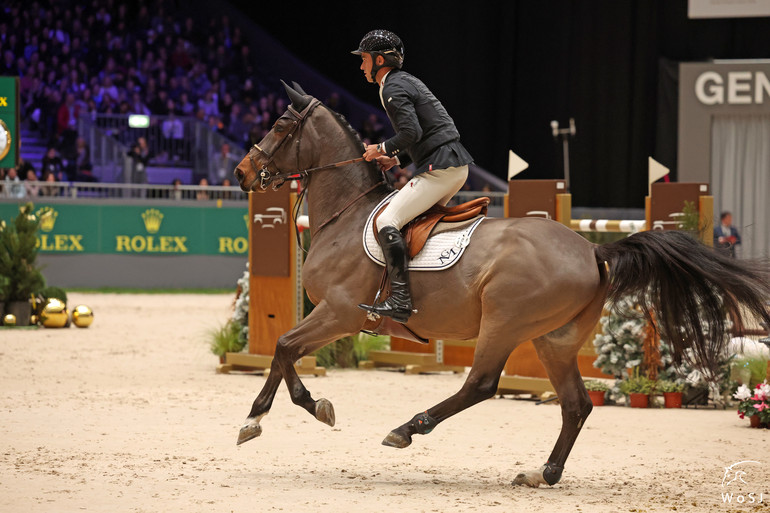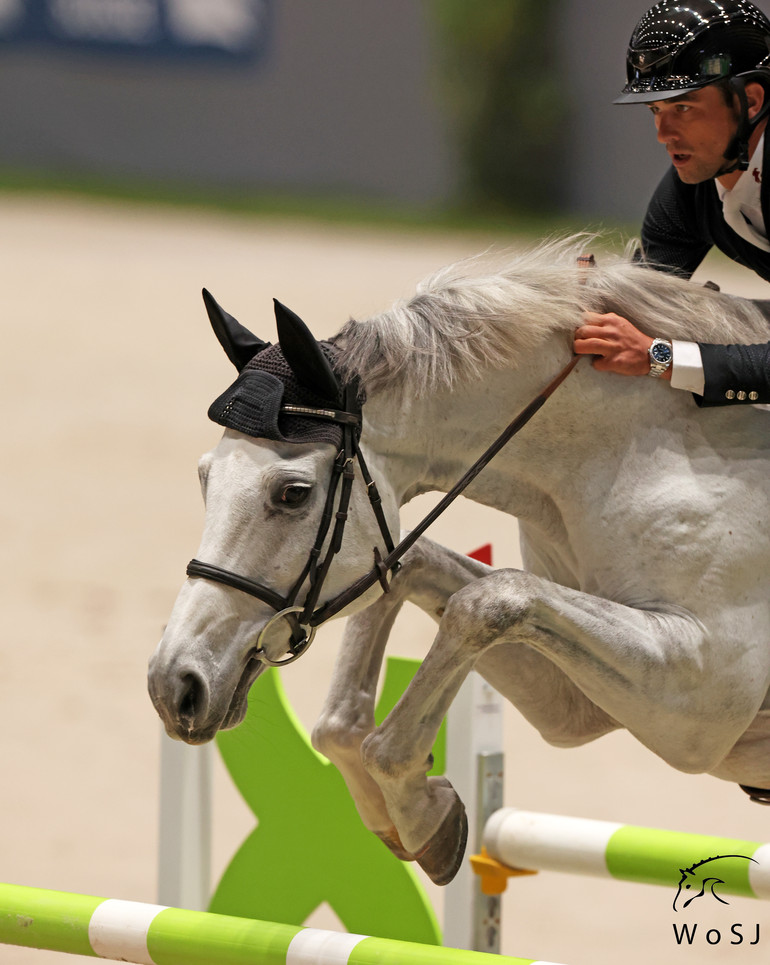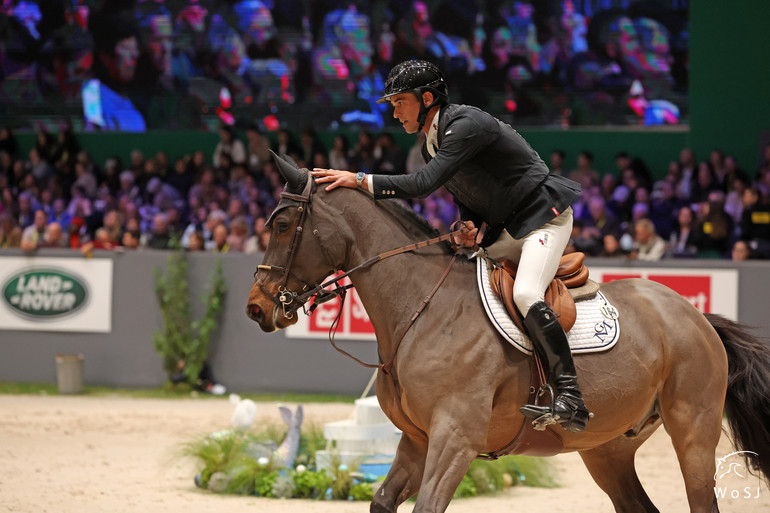Text © World of Showjumping
“With horses, it all comes down to creating a good connection,” Luxembourg’s Victor Bettendorf – who during the 2022-season impressed with his effortless, minimalistic style; recording 54 international wins while competing his horses barefoot and without protective front boots – tells World of Showjumping. “When I ride, I am simply happy to sit on a horse, and to have a connection with them,” the 33-year-old says. “The bond you have with each horse is unique, because they are all individuals, and there is something special in each of them.”
Born with it
Bettendorf, who currently sits 38th on the Longines Ranking, was born into an equestrian family; his father is a passionate breeder and competed up to 1.45m level nationally. “I don’t remember a time without horses,” Bettendorf laughs when he looks back. “Honestly, I didn’t have a choice, because we would spend all our time in the stables.”
Actually, as a child, I never really enjoyed it
“One of my earliest memories is riding in my mom’s pony class, but actually, as a child, I never really enjoyed it,” he continues. “I was more into basketball, and I had a motor bike. When we went to the shows, I preferred to ride around on that bike. However, I loved competing; I am competitive in every sport by nature, so that was the fun part of riding for me – but training at home and all the work around it I did not like. I had a really good pony, and I did the European Championships for ponies twice – even if I never really trained properly at home!”
Sorbier Blanc
But then came Sorbier Blanc (Jericho Pierreville x Voltaire). “Riding was just a small part of my life until Sorbier Blanc came along. I got him when he was four, and that is when everything changed for me,” Bettendorf tells. “I became motivated to work at home, I wanted to get better in my flatwork… He was such a big-hearted horse as well as a great jumper and I really enjoyed the connection I had with him. With him, I started to win more, which gave me even more motivation; I wanted to become more consistent and get to the higher level.”
He started my career, and he made me want to be a better rider
“I started with him when he was four; we did the youngster classes together and as an eight-year-old he jumped the Nations Cup in Celje,” Bettendorf continues. “He ended up doing the European Championships in Aachen in 2015 and in Rotterdam in 2019 as well. He was so good that I was able to jump classes I was not ready for; he was able to do it, even though I was not good enough. Although I started with him as a young horse, it was never about me making him better; he started my career, and he made me want to be a better rider.”
Standing on his own feet
When Bettendorf was 24, he left Luxembourg for Germany to pursue his dream of becoming a professional rider. “I was on my own in Germany for five years, close to the border of Luxembourg. I told my father that I wanted to start something on my own – and he let me go, probably thinking that I would not even last six months.”
I told my father that I wanted to start something on my own – and he let me go, probably thinking that I would not even last six months
“However, I was really committed; I wanted to be a professional and earn my own money,” Bettendorf says. “I never wanted to be employed by anyone; I wanted to be self-employed and able to work with the people I wanted to, make my own decisions, and not be prisoned by one owner. After five years, I came to a point where I thought I had two options; stay at two- and three-star level and keep my clients or change the whole plan and try my best in making it to the highest level. That was the turning point for me. After meeting my girlfriend Adeline Hecart, I moved to France, and I think that was the right decision: The system we started three years ago is proving to work.”
Haras de La Roque
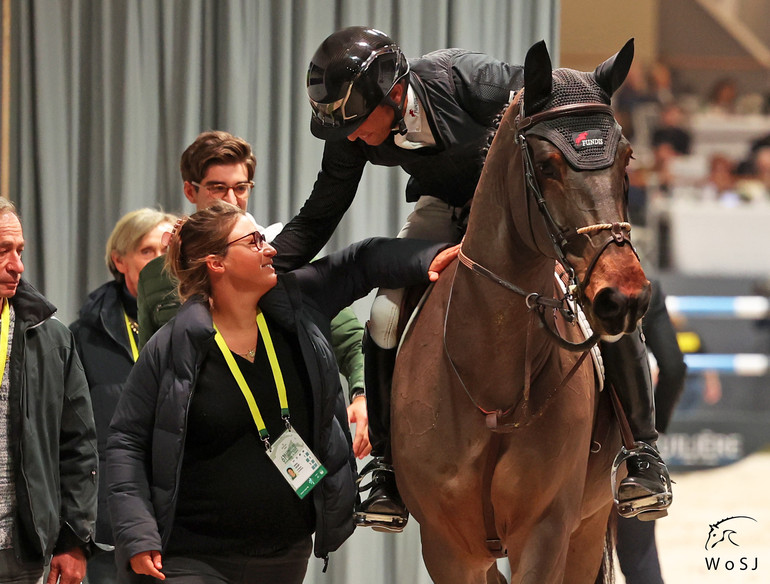
"Adeline actually plays the biggest part; she helps me every day, we make all the plans together, and without her, the whole thing would not work as it does – I am very thankful for her and lucky to have such a supportive partner," Bettendorf says about Adeline Hecart. Photo © Jenny Abrahamsson for World of Showjumping.
For the last three years, Bettendorf has been based in Normandy, France. “I recently bought a stable together with Adeline, and it is a nice little place. We have some really good owners, with Michel and Alexandrine Hecart as well as the Megret-family supporting us. We have a lot of horses; including the young ones around 35 that are in competition – from five-year-olds to older ones. We have a system at home – with Adeline and our owners – that is really working well. However, Adeline actually plays the biggest part; she helps me every day, we make all the plans together, and without her, the whole thing would not work as it does – I am very thankful for her and lucky to have such a supportive partner. We never put pressure on the horses, and my owners never put pressure on me; I can enjoy every show, and I hope it will continue like this.”
With Haras de La Roque, the Hecart-family has one of the best breeding stables in the world
“With Haras de La Roque, the Hecart-family has one of the best breeding stables in the world,” Bettendorf says. “At CHI Geneva last December, they had five de La Roque-horses competing, which is quite unique. From them, I have learned a very simple approach towards the horses: They are ridden as four-year-olds, and once they are used to the saddle, they go back in the field. When they are five, they maybe do a few shows, but really small, and when everything works, they return to the field again. When they are six, this process is repeated; they do the minimum of classes they need to keep up with their age group. The first time they really start competing, is when they are seven.”
“Our horses live outside, and we take it very slow with their development,” Bettendorf explains. “We try to preserve them as much as we can for the real sport, which starts when they are around nine.”
Learning from the best
Being part of the Hecart-family – one of the most prominent and respected names in the industry – has come with many valuable lessons for Bettendorf. Having his horses barefoot is an approach Michel Hecart chose several years ago. “It is a system that works well for us, because our horses live outside a lot and all together,” Bettendorf tells. “This way, if they kick, they don’t get injured. I think the horses feel more comfortable too, and it is more natural for them so it is a system I believe in. I don’t use protective front boots on my horses, because Adeline had a horse that fell in a combination and actually got injured because of the boots. After that, I don’t use boots… I don’t need them anyway when my horses don’t have shoes.”
I have learned so much from Michel; I think he is one of the best horsemen there is
“Because I was not focused on training when I was younger, there are many details in my riding that I miss today – I have a lot to catch up on,” Bettendorf continues. “I have learned so much from Michel though; I think he is one of the best horsemen there is – he knows horses, and he is extremely sensitive in his flat work. That is something I am trying to learn. However, I am starting to understand how to feel the horses on flat; knowing not to do too much, being very precise with the things I am asking from the horses. You always have to ask them in a very simple way, so that it is easy for them to understand you. At the end, with the horses, you just need the throttle, the break and steering – if that works, you have 90% of the job that is done in the course.”
Never ride with your hands
“What I focus on in my flat work, is that I can control the balance of the horse, that I can turn the shoulders – and never ride with the hands,” Bettendorf tells about his approach to working the horses. "The hands are just there to help your legs and your seat, but they are not there for pulling. I focus on making sure the horses learn to push from their hind legs, this way you have no weight in your hands. As soon as you have weight in your hands, you are losing speed, because then you are trying to steer with your hands. This is something Michel works on a lot; he goes forward, breaks, turns… In general, I use my aids as little as possible but with the aim to have the biggest possible reaction. When Michel is asking something, things you maybe don’t even see, the horse has to react.”
What I focus on in my flat work, is that I can control the balance of the horse, that I can turn the shoulders – and never ride with the hands
“When I was younger, my father taught me a lot and he was inspired by the American riders,” Bettendorf continues. “He used to say that their riding looked effortless, and when it looks like that, it is the right way – if riding looks complicated, it is not nice to watch and not admirable. My father always said, ‘when people see you ride, they have to think that riding a horse is easy; they have to think they can do the same’ – and this mindset has really stayed with me. Our sport is getting so fast now, and it is difficult to sit on a horse like Marlon Zanotelli or Julien Epaillard. To stay aesthetic when you ride fast is not simple.”
Looking up
“I have always tried to learn from many different people, and I have learned a lot by looking at others – trying to copy what they do,” Bettendorf – who besides his father has never really been traditionally trained by anyone – tells. “Now I am very lucky to have Michel helping me a lot, but he is not my coach in a traditional sense. He rides the horses a lot, and that helps; when I sit on a horse after Michel has been riding it for three days, everything works! It is incredible. Adeline helps me a lot as well, she comes to all the shows and is there for me in the warm-up so they are both very important for me.”
I have learned a lot by looking at others
“When I was younger, I looked up to Rodrigo Pessoa. He was someone who was a bit out of the ordinary; there were good riders, but he was on top of everyone,” Bettendorf says. “As I got older, I have three riders I admire a lot, for different reasons: I admire Steve Guerdat for his elegance and patience with the horses, for his capability to always find new horses and to be ready the day he wants to be good; Julien Epaillard for his ability to win on all types of horses, he has a natural sense of speed; Kevin Staut for his discipline and work with the horses, and for being such a strongminded person. I think he is the only person who is able to recover totally after a bad round, and go out again to jump clear.”
Enjoying every moment
While some might think of breaking into the five-star scene as intimidating and stressful, Bettendorf sees it as a privilege and pure joy. “I am in a very easy position; I have nothing to lose,” he says. “As an example, all the riders I saw in Geneva, are riders I am used to watching on TV, not competing against. For me there is nothing to prove, I am just lucky to be here. Maybe if I was lucky enough to compete on the highest level for years and years, probably the pressure would grow, because you want to confirm your results. However, I just want to enjoy every moment; there are so many riders who would love to compete at the events that I got to do during 2022. Having the horses that I have now is a gift, as is being able to compete on this level. I try to not put any pressure on myself, but simply listen to my horses and feel if they are ready or not. And when it does not work one weekend, maybe it does the next.”
For me there is nothing to prove, I am just lucky to be here
“This year, I would like to compete more on the five-star circuit, but for Luxembourg it is complicated because we don’t have a team and I cannot do the World Cups,” Bettendorf tells about his plans for 2023. “Maybe my current ranking will help me get invitations. Now I am just inside the top 40, but I think the difference between the top 40 and the top ten is the same as the difference between the top 500 and the top 100 – you have to be so competitive, not only at the small shows, but on the biggest shows, with the best horses and the best riders. Of course, I have ambitions, but for now I am just lucky to have good horses and record some good results.”
“I think I need to gather more experience and learn from the good riders who have good systems, who always have new horses coming up… To have one good horse, and do some nice shows once, I am not saying it is easy, but it is possible – but staying on the top, for a longer period, with different horses… that is something I would say is really admirable and something I am aiming for,” Bettendorf says. “However, the next few years will just be about stabilizing myself on this level and finding the right horses – and maybe then I can reach for higher goals. In the future, I wish to have a nice stable with some good breeding mares and be able to do the high-level sport – but without too much pressure, so that I can still enjoy it. And hopefully, go to the shows with my children!” Bettendorf concludes.
17.1.2023 No reproduction of any of the content in this article will be accepted without a written permission, all rights reserved © World of Showjumping.com. If copyright violations occur, a penalty fee will apply.



